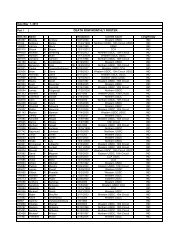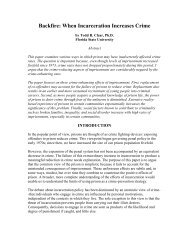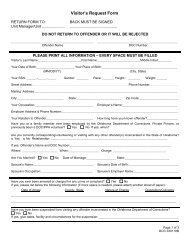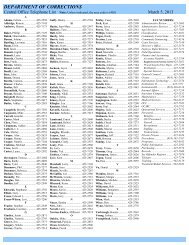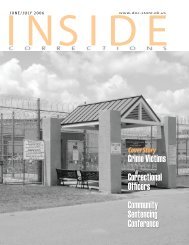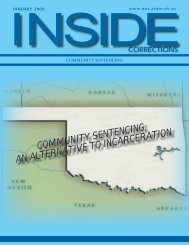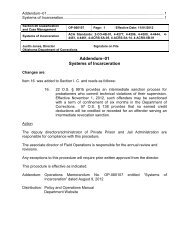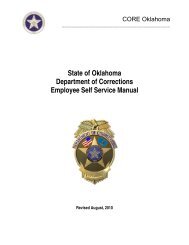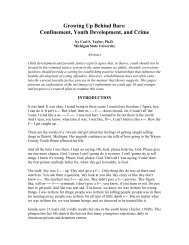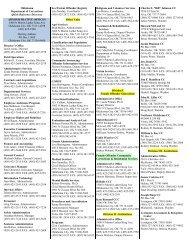Programs, Mental Health, Medical & Education - Oklahoma ...
Programs, Mental Health, Medical & Education - Oklahoma ...
Programs, Mental Health, Medical & Education - Oklahoma ...
Create successful ePaper yourself
Turn your PDF publications into a flip-book with our unique Google optimized e-Paper software.
2002). The new curricula were chosen<br />
because they addressed root causes of<br />
substance abuse and trauma specific to<br />
women involved in the criminal justice<br />
system. The materials were introduced<br />
and pilot tested (through statistical<br />
and focus group methods) at Dr. Eddie<br />
Warrior Correctional Center in 2006<br />
and found to fit the need and problem<br />
areas specific to female offenders.<br />
The curricula, group and individual<br />
therapeutic counseling services addressed<br />
substance abuse, trauma and mental<br />
health issues to high risk female offenders<br />
and were provided through a generous<br />
grant from the George Kaiser Family<br />
Foundation. Program goals included:<br />
1) to provide a gender-specific treatment<br />
program for women who abused alcohol<br />
and other drugs, 2) to provide an<br />
integrated treatment of substance abuse<br />
trauma and recovery, and 3) reduce<br />
recidivism through substance abuse<br />
treatment and the practice of pro social<br />
behavior.<br />
Program Implementation<br />
To implement the Helping Women<br />
and Beyond Trauma treatment program<br />
systematic assessment tools were useful<br />
to select high risk participants. In<br />
addition, licensed therapists who were<br />
Helping Women Recover - Treatment and Rehabilitative Services<br />
...includes domestic violence and relapse prevention<br />
interventions and participants receive 11 hours of group<br />
treatment each week for four months and up to six<br />
individual therapy sessions<br />
experienced with and also licensed in<br />
alcohol and drug counseling were hired<br />
to be positive role models and to conduct<br />
group and individual therapeutic<br />
services for participants. Therapists were<br />
also eager to provide a strength-based<br />
model of treatment delivery focusing on<br />
skill acquisition rather than symptom<br />
management and acknowledged the<br />
importance of what happened to the<br />
female offender rather than what<br />
was wrong with her. The Stephanie<br />
Covington manualized curricula and<br />
facilitator guides were studied to learn<br />
how to best conduct the intervention<br />
services and staff training was provided.<br />
Dr. Covington provided consultation as<br />
therapists progressed through the written<br />
material and she eagerly answered our<br />
questions. Program policy was followed,<br />
and fidelity checklists were developed<br />
to be certain that program design was<br />
faithful to curriculum theory. And,<br />
of course like all other new knowledge<br />
paths, many new lessons were learned.<br />
One such lesson was the realization that<br />
Department of Correction’s substance<br />
abuse treatment programs had to be<br />
certified through an audit conducted<br />
by the University of Cincinnati known<br />
as the Community <strong>Programs</strong> Checklist<br />
(CPC). The CPC is used to assess how<br />
closely correctional programs meet the<br />
known concepts of effective intervention<br />
(Latessa, 2006). Another lesson learned<br />
was that higher CPC scores had a direct<br />
relationship to lower levels of recidivism.<br />
And thirdly, our substance abuse and<br />
trauma interventions needed to be<br />
augmented with additional curriculum<br />
and provide a minimum of nine treatment<br />
hours each week for a minimum of<br />
four months. Determining additional<br />
curriculum meant seeking the advice of<br />
subject matter experts, speaking to the<br />
women in treatment about their needs<br />
for sobriety, and discovering additional<br />
assessment instruments to determine<br />
treatment intensity. A quality assurance<br />
plan was developed and implemented<br />
that addressed the following concepts:<br />
program planning, offender recruitment<br />
and engagement and an evaluative<br />
process that measured intermediate and<br />
long term objectives.<br />
Current Status<br />
Today, Helping Women Recover: A<br />
Program for Treating Substance Abuse<br />
and Beyond Trauma: A Healing Journey<br />
for Women is conducted at Dr. Eddie<br />
Warrior Correctional and Mabel Bassett<br />
Correctional Centers. Both are approved<br />
(continued on page 36)<br />
INSIDE CORRECTIONS 21



